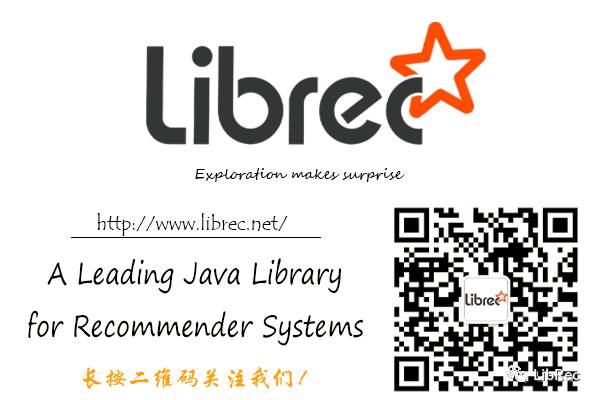LibRec 精选:推荐模型的包容与公平性
推荐进展 第7期(更新至2018.6.10),分为社交关注和论文进展两部分,其中论文的摘要部分经过句子抽取算法处理过。
社交关注
推荐系统的论文通常关注于推荐的准确性,而Google与Netflix的研究人员开始讨论一些新的主题:inclusion 和 fairness。相关的Talk:
- Beyond Being Accurate: Towards More Inclusive and Fairer Models using Focused Learning and Adversarial Training
- by Ed H. Chi, Alex Beutel, et al.
3篇相关的论文
+ Data Decisions and Theoretical Implications when Adversarially Learning Fair Representations, https://arxiv.org/abs/1707.00075
+ Beyond Globally Optimal: Focused Learning for Improved Recommendations, http://alexbeutel.com/papers/www2017_focused_learning.pdf
+ Latent Cross: Making Use of Context in Recurrent Recommender Systems, https://static.googleusercontent.com/media/research.google.com/en//pubs/archive/46488.pdf
论文进展
1. Conversational Recommender System
Yueming Sun, Yi Zhang
https://arxiv.org/abs/1806.03277v1
A personalized conversational sales agent could have much commercial potential. However, the research on this topic is very limited and existing solutions are either based on single round adhoc search engine or traditional multi round dialog system. In this work, we propose to integrate research in dialog systems and recommender systems into a novel and unified deep reinforcement learning framework to build a personalized conversational recommendation agent that optimizes a per session based utility function.
2. Graph Convolutional Neural Networks for Web-Scale Recommender Systems
Rex Ying, Ruining He, Kaifeng Chen, Pong Eksombatchai, William L. Hamilton, Jure Leskovec
https://arxiv.org/abs/1806.01973v1
Recent advancements in deep neural networks for graph-structured data have led to state-of-the-art performance on recommender system benchmarks. We develop a data-efficient Graph Convolutional Network (GCN) algorithm PinSage, which combines efficient random walks and graph convolutions to generate embeddings of nodes (i.e., items) that incorporate both graph structure as well as node feature information. To our knowledge, this is the largest application of deep graph embeddings to date and paves the way for a new generation of web-scale recommender systems based on graph convolutional architectures.
3. CoupleNet: Paying Attention to Couples with Coupled Attention for Relationship Recommendation
Yi Tay, Anh Tuan Luu, Siu Cheung Hui
https://arxiv.org/abs/1805.11535v1
In this paper, we present a text-based computational approach for estimating the relationship compatibility of two users on social media. CoupleNet utilizes hierarchical recurrent neural models for learning representations of user profiles and subsequently coupled attention mechanisms to fuse information aggregated from two users. To the best of our knowledge, our approach is the first data-driven deep learning approach for our novel relationship recommendation problem.
4. Collaborative Multi-modal deep learning for the personalized product retrieval in Facebook Marketplace
Lu Zheng, Zhao Tan, Kun Han, Ren Mao
https://arxiv.org/abs/1805.12312v1
Facebook Marketplace is quickly gaining momentum among consumers as a favored customer-to-customer (C2C) product trading platform. Building the recommendation system for Facebook Marketplace is challenging for two reasons: 1) Scalability: the number of products in Facebook Marketplace is huge. In this paper, we propose to address both the scalability and the cold-start issue by building a collaborative multi-modal deep learning based retrieval system where the compact embeddings for the users and the products are trained with the multi-modal content information.
5. A Sequential Embedding Approach for Item Recommendation with Heterogeneous Attributes
Kuan Liu, Xing Shi, Prem Natarajan
https://arxiv.org/abs/1805.11008v1
To overcome the challenges and to harvest the advantages of sequence models, we present a novel approach, Heterogeneous Attribute Recurrent Neural Networks (HA-RNN), which incorporates heterogeneous attributes and captures sequential dependencies in \textit{both} items and attributes. HA-RNN extends recurrent neural networks with 1) a hierarchical attribute combination input layer and 2) an output attribute embedding layer. Our ablation experiments demonstrate the effectiveness of the two components to address heterogeneous attribute challenges including variable lengths and attribute sparseness.
6. WikiRef: Wikilinks as a route to recommending appropriate references for scientific Wikipedia pages
Abhik Jana, Pranjal Kanojiya, Animesh Mukherjee, Pawan Goyal
https://arxiv.org/abs/1806.04092v1
Unfortunately, the references which support the content of each Wikipedia entity page, are far from complete. Why are the reference section ill-formed for most Wikipedia pages? In the following step, we recommend references to the target page from the reference section of the wikilinks that are classified as potential sources of references in the first step.




